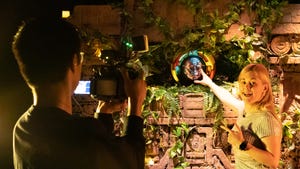
Hello to Holograms: Our Chat With a Talking, Floating Head - CNET
The room is dark. There’s a quiet whirr of fans. Nature sounds play from unseen speakers. One wall is decorated with what I assume is artificial greenery. In the center, a head. Blue and purple and angular, it floats in a darkened space. The head glows as if it’s on a screen, but no screen is visible. It looks like it’s just hanging in the air.
And then, the head speaks.
A voice booms through the speakers. First a greeting, then some witty banter. All the while, the glowing, disembodied head follows my movement. Its eyes track me, and its mouth moves with its words. The illusion is impressive, to say the least, but of course it’s a hologram.
Light Field Lab, a company we first visited in 2021, keeps improving its holographic technology, and the latest example is this talking head. It not only looks more realistic than ever, but now it moves and interacts in real time. Are we looking at the future of visual entertainment? Here’s what we found out.
Faces of light
A simplified version of how Light Field Lab’s holographic tech works. If you put a magnifying glass in front of an object, then look through a second magnifying glass a short distance away, the original object seems to float in mid-air.
Light Field Lab.
Let’s back up slightly and talk about holograms. Plenty of technologies describe themselves as holograms when they really aren’t. A few years ago, a tech company made big headlines by putting a “hologram” of Tupac on tour. This was really just an updated version of an effect called Pepper’s Ghost that dates back to the mid 1800’s. If you’ve ever been to a Disney park, you’ve seen this trick in the Haunted Mansion.
Then there’s the various autostereoscopic “glasses-free” 3D and spinning LED wheels, neither of which are holograms. The oddly colored 3D objects and images specifically called holograms, well those are actually holograms. But the way they’re created and viewed doesn’t lend itself to high-resolution motion video.

The stages of Light Field Lab’s holographic display.
Light Field Lab
What Light Field Lab is doing is different from these other technologies. They’re using billions of pixels, and some extremely microscopic tech, to get light beams to interact. The effect, to your eye, looks like an object floating in space. By combining several of their custom modules, it will be eventually possible to have wall-size holograms that seem to pop out into space.
For the deeper explanation of the technology, check out our original report Holograms get real: Startup creates objects out of light and thin air.
Heads-up interaction
Getting a hologram to look 3D in pictures or video is basically impossible. Having seen it in person however, I can report it’s extremely impressive. Unfortunately, it’s still not very big. The talking head I chatted with wasn’t quite the size of a full-size head. But still, it was a talking, floating head!

Exploded view of one of the modules.
Light Field Lab
At first, Light Field Lab tried to convince us they had an advanced, interactive AI powering the colorful head. I was immediately suspicious, however, since one of the first questions it asked me was if I spelled my name with a “G” or a “J.” That’s a bit esoteric for a computer, but otherwise the interaction was a convincing subterfuge.

One of Light Field Lab’s prototype modules. A typical video wall would just have the front portion, not all the heavy duty processing behind it.
Geoffrey Morrison/CNET
The way it actually works is, I think, far more impressive. In another part of the building, an LFL employee was having his face rendered and converted into the colorful noggin’ we were seeing — all in real time. It was done over Wi-Fi, but the technology could be done over just about any Internet connection. Imagine having a FaceTime conversation with a life-size, 3D hologram of your mom, standing in your room. Hopefully, she won’t be able to see how messy it is.
The holographic future

One possible use for the Light Field Lab tech: holographic movies on theater-sized screens. The shark will probably still look fake.
Light Field Lab
We’re several years away from these kinds of holograms becoming a mainstream technology. One reason is that the modules have pixel densities an order of magnitude higher than typical displays. A 4K TV has millions of pixels. These displays have billions. They require immense processing power to get each of those pixels to do what Light Field Lab needs them to do in order to create the hologram. And that’s not even counting the “secret sauce” PhaseGuide that lets you see those pixels as a hologram.
All this is goes beyond just a neat Silicon Valley tech demo. It has caused a lot of major companies to invest, most recently a $50 million Series B round of funding led by South Korean game developer NCSOFT. They join a veritable who’s who in tech, including both LG and Samsung (how often do you see those two together?), as well as Verizon, Bosch, Comcast, Corning, Gates Frontier and others.
The potential here is wall-size holograms in movies and theme parks, theater-size displays for a new (ahem) dimension in entertainment, and maybe someday, the Holodeck experience we’ve long dreamed for.

